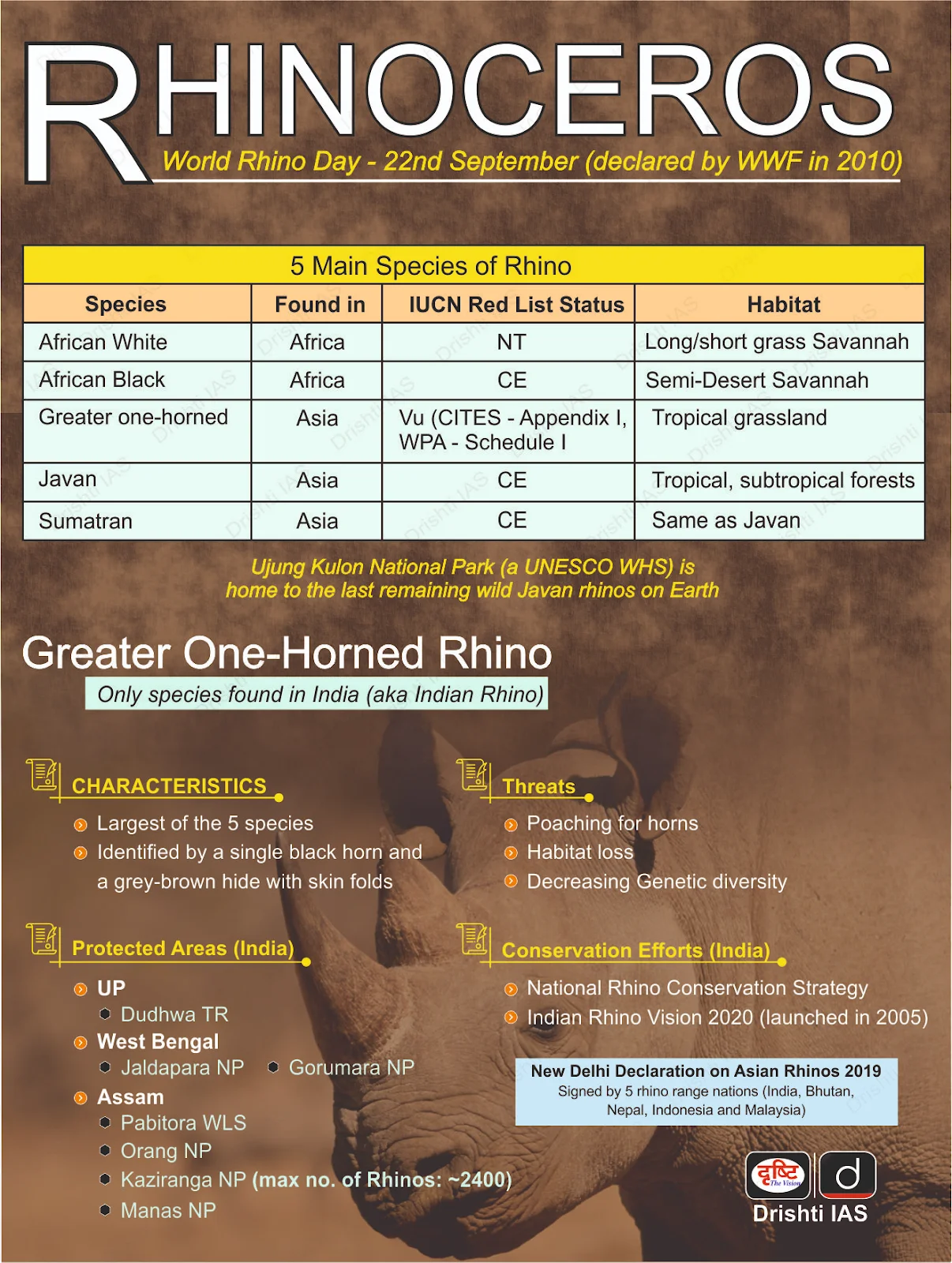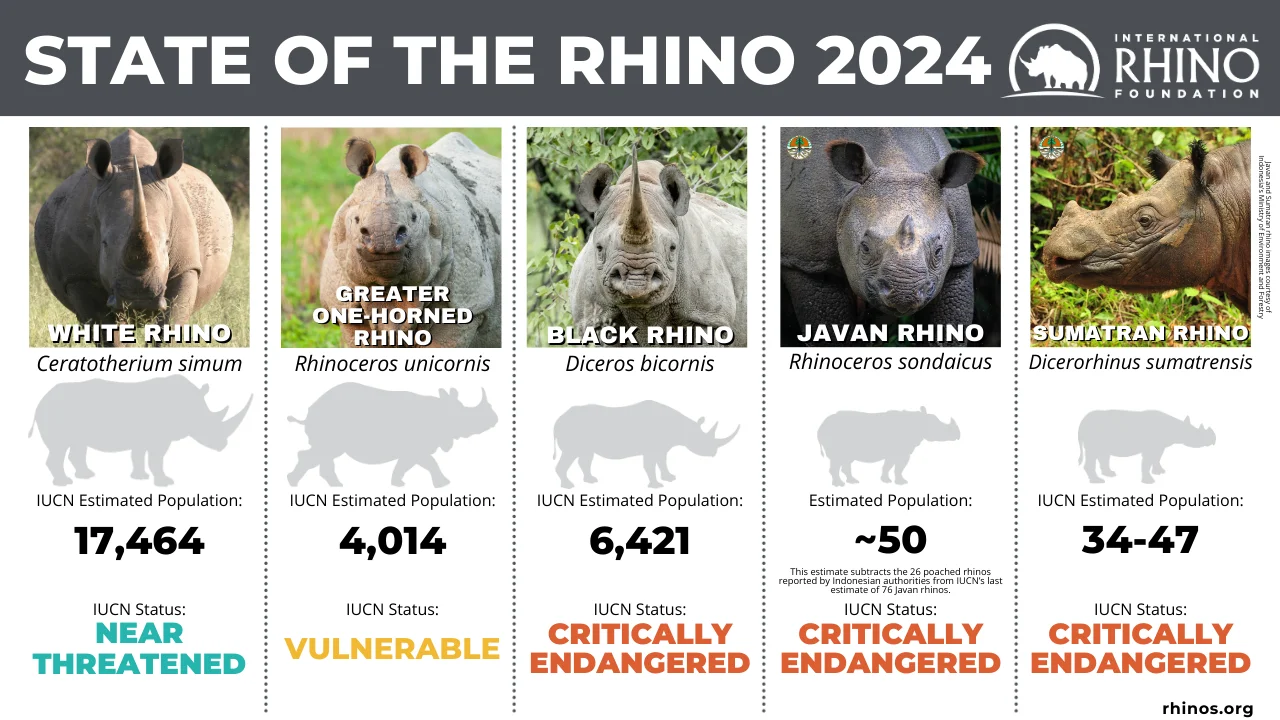Rhisotope Project | 11 Aug 2025
Why in News?
South African University, in collaboration with the International Atomic Energy Agency (IAEA) has launched an innovative rhino anti-poaching initiative using radioactive isotopes (radioisotopes), called the Rhisotope Project.
What is the Rhisotope Project?
- About: It involves a non-invasive procedure where measured low doses of radioisotopes are injected into the horns of live rhinoceroses.
- This makes the horn useless and toxic for human consumption, while the procedure is safe for rhinoceroses.
- Advantages:
- Radioactively treated rhino horns are identifiable by Radiation Portal Monitors (RPMs) and scanners at borders, ports, and airports, even inside fully loaded containers.
- Radioactive markers make horns dangerous to smugglers and less marketable in illegal trade, discouraging poaching.
What are Radioisotopes?
- About: Radioisotopes are radioactive isotopes with unstable atomic nuclei that emit ionizing radiation (alpha, beta, or gamma) to achieve a more stable nuclear configuration.
- It is caused by an imbalance between neutrons and protons in the nuclei. Eg: Carbon-14 (C-14) & Tritium (H-3).
- To achieve stability, they emit energy and particles which can be detected with devices such as a Geiger counter or photographic film.
- Isotopes: Isotopes are atoms of the same element having the same atomic number (protons) but different mass number (protons + neutrons).
- Eg: Protium, Deuterium & Tritium (isotopes of hydrogen).
- Applications:
- Medicine (I-131 for thyroid diagnostics, Tc-99m for imaging), Industry, Power generation, Archaeology (C-14 dating).
Major Threats to Rhino
- Poaching: It remains the most severe threat, causing population declines and local extinctions.
- Invasive species: Invasive species (like Parthenium) threaten habitats by outcompeting native rhino food plants, limiting available range.
- Climate change & Human-Wildlife Conflicts: Climate change intensifies monsoons and droughts in Asia, pushing Rhinos out of their habitats. This forces them into human areas, increasing human-wildlife conflict.
Note:
- Parthenium (Congress grass) is threatening Assam’s Pobitora Wildlife Sanctuary, which hosts the world’s highest density of one-horned rhinos, by causing skin allergies, fever, lowering agricultural productivity, and damaging biodiversity.
- It is a highly invasive flowering plant from the Asteraceae family, & native to the Americas.
- It possibly entered into India along with wheat imported from the US in the early 1950s and has since spread aggressively across about 1 million hectares of fallow land nationwide.
Conservation Initiatives for Rhinos
- New Delhi Declaration on Asian Rhinos
- DNA Profiles of all Rhinos
- National Rhino Conservation Strategy
- Indian Rhino Vision 2020
International Atomic Energy Agency (IAEA)
- The IAEA is an intergovernmental organisation founded in 1957, to promote the peaceful applications of nuclear energy and works to prevent its use for military purposes, such as nuclear weapons.
- It was founded as the UN’s “Atoms for Peace” organisation and operates under its own founding treaty, the Statute of the IAEA.
- It reports to both the UN General Assembly and the UN Security Council & is headquartered at the UN Office in Vienna, Austria.
- It comprises 178 member states, with India as a founding member & was awarded the 2005 Nobel Peace Prize for contributions to nuclear safety and peace.
UPSC Civil Services Examination, Previous Year Question (PYQ)
Prelims:
Q. Consider the following statements in respect of Trade Related Analysis of Fauna and Flora in Commerce (TRAFFIC): (2017)
- TRAFFIC is a bureau under the United Nations Environment Programme (UNEP).
- The mission of TRAFFIC is to ensure that trade in wild plants and animals is not a threat to the conservation of nature.
Which of the above statements is/are correct?
(a) 1 only
(b) 2 only
(c) Both 1 and 2
(d) Neither 1 nor 2
Ans: (b)
Q, Consider the following statements: (2019)
- Asiatic lion is naturally found in India only.
- Double-humped camel is naturally found in India only.
- One-horned rhinoceros is naturally found in India only.
Which of the statements given above is/are correct?
(a) 1 only
(b) 2 only
(c) 1 and 3 only
(d) 1, 2 and 3
Ans: (a)


